#reusable UI
Explore tagged Tumblr posts
Text
Building a Component Library for NextJS: A Guide to Reusable UI
Building a Component Library for NextJS: A Guide to Reusable UI Have you ever found yourself rewriting the same UI components over and over again in your NextJS projects? Have you struggled to maintain consistency and efficiency across multiple applications? If so, it’s time to consider building a component library. A component library is a collection of reusable UI elements that can be shared…
#building component library#Component Library#Design#development#front-end#NextJS#NextJS component library#reusable#reusable UI#UI
0 notes
Text
Learn how the development of reusable UI components helped significantly enhance UI and implement consistency across their other web applications.
0 notes
Note
so how extensive is the crystal forcefem mod? is it just all pokemon and trainers are female, or what?
player and all Pokemon and most NPCs are girls (working on that), various quality of life improvements (automatic running shoes on the b button, automatic full party exp share, gay breeding, reusable TMs), some later-gen features (fairy type, physical/special split by move rather then type), some design changes to make the dex completable in single player (more diverse wild pkmn spawns, trade evolutions replaced by item evolutions), some party changes to make gym leaders more interesting, some new areas to flesh out the cut Kanto locations (a park where the safari zone used to be, a separate viridian forest, a more rebuilt Cinnabar Island), some absolutely terrible UI art changes bc i am a child drawing on the walls with crayons, optional wild pkmn level scaling based on how many gym badges you've earned, occasional silly text changes, and some more higher-level / post-game battles.
rom: https://drive.google.com/file/d/1s0D9IBvbPKisDScbwj8b3JYHILXgUCJD/view?usp=drivesdk
source code:
https://github.com/weepingwitch/pokecrystal/tree/willowcrystal/
57 notes
·
View notes
Text
Hello audience. Unfortunately, I am still on my break. However, I am happy to announce that I am still alive and kicking. In fact, I decided to make use of my unemployment and revisit HTML, CSS, and JavaScript to create... A visual novel.
Good News: code is 100% reusable because I used a JSON (i do not know how that works, someone can kindly explain to me...)
Bad News: this code sucks ass, and NOTHING works except playing the story. Transitions? Doesn't work. UI/UX? Ass. Effects? Hell no... Also, 70% of the features aren't present yet I'm gonna do it later.
Oh, this is CrossDust, if you can't tell.
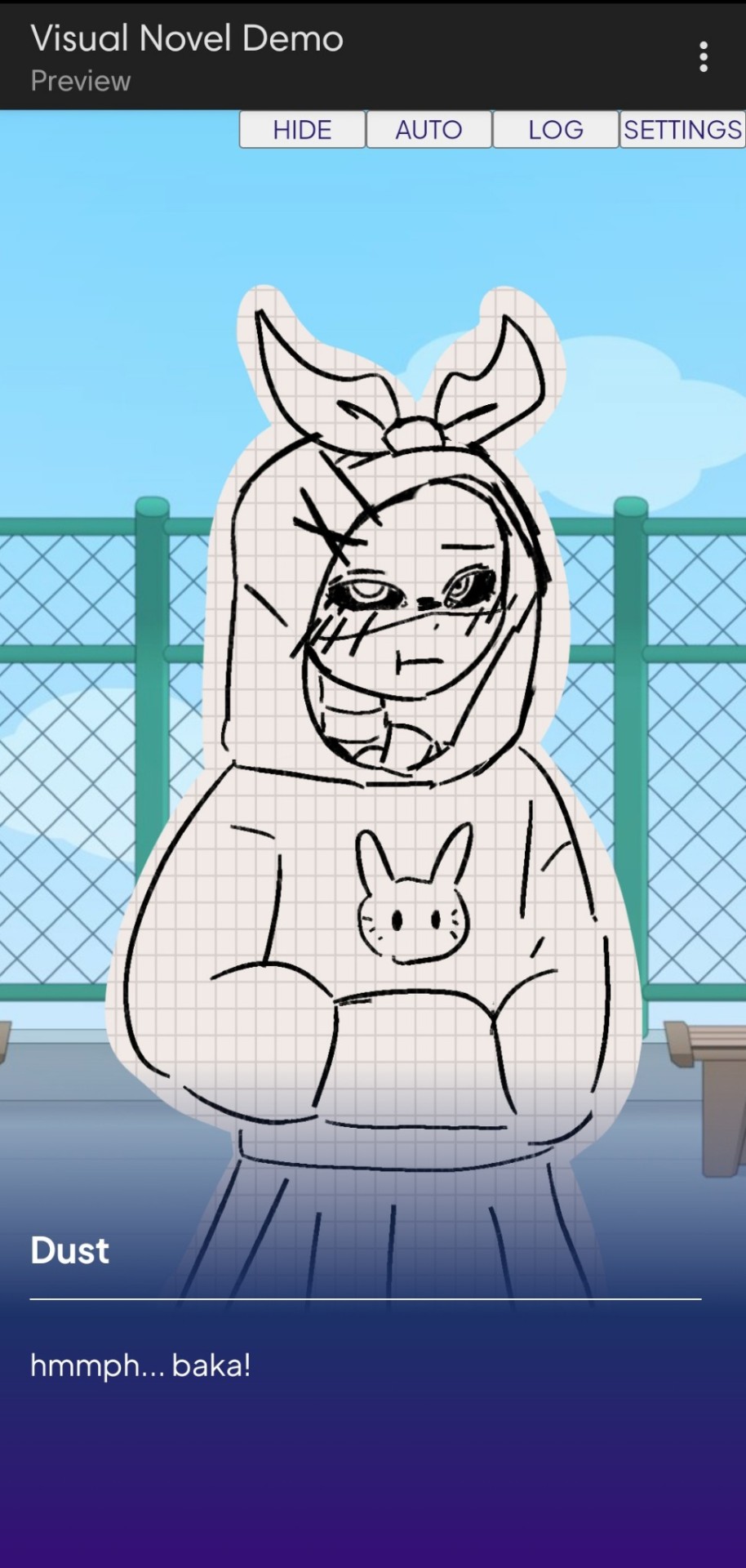
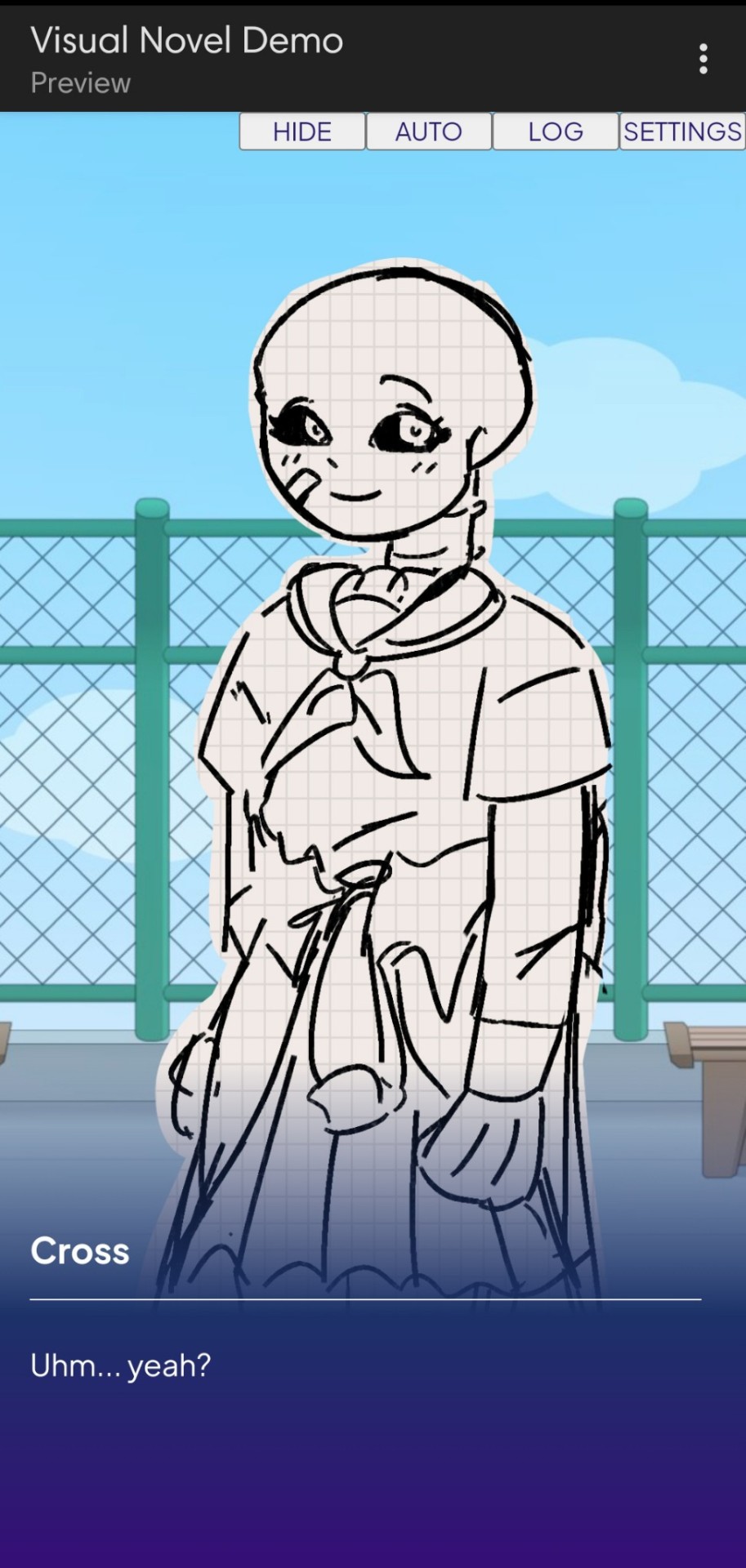
Dust Sans by Ask-Dusttale, Cross Sans by Jakei
I'm gonna respond to asks and do requests later (After my break is over). This is just a small update teehee.
#dsevalyappuccino#TIME TO GO INSANE IN THE TAGS!!#i hate css#i still hate css#css hell no#guys why is css so hard. ive literally been doing this for months and css is still hard#i was about to use css spritesheets for the sprites and emotions#but my ass gave up and instead i just use seperate images#GUYS!!! DISPLAY: FLEX 💪. DISPLAY: GRID?!?!#javascript i hate you tooq#i hate java script naurrrr#what do you mean DOM objects#what do YOU MEAN#also i do not understand error handling and JSON integrations#papaGPT doesn't explain anything#i don't know what I just wrote#coding???????????#kids don't be unemployed#actually maybe if you're unemployed but still making money that's great#also the sprites are just for testing purposes im probably gonna make new better ones if i chose to expand this into#a full blown anime high school visual novel project#i don't wanna think of all that story crap but then again i can just write the cringiest thing on earth
23 notes
·
View notes
Note
Hi there, Love your work! I'm also doing stuff in Unreal and it feels like it's rarer to find other indie devs using it. I love how clean all your UI feels, and UI is something I seem to really struggle with.
Do you have any recommendations for workflows / tips / sources etc for getting better at UI?
Also I'd love to know more about the material / shader workflow for your latest post if you have more information anywhere.
Thanks :)
Hello there! Thank you!! I hope you don't mind me answering publicly as I feel like some people might be interested in the answer!
I really appreciate your UI (User Interface for those not knowing the acronym) compliment as it's something I've spent a long time working on and specializing in, in my career as a software engineer. UI/UX often goes completely unacknowledged or taken for granted even though it takes a lot of time and hard work to create and develop. In the engineering world I frequently had to advocate for and explain user experiences to those who didn't have as deep of an appreciation for UI or a very sophisticated understanding of why a good, visually appealing user experience makes, or on the flip side, can break everything. I think it's a very challenging, overwhelming topic to grasp and communicate, but just by being interested in it you're already way ahead!
There's a lot going on with UI. From visuals to knowing common design elements to successfully conveying a story to the user to implementation to testing to designing for accessibility to animation and I probably didn't cover everything with that run-on sentence. There's frontend engineers out there whose role is solely to maintain and improve UI component libraries for companies. And that's without throwing games, whose UIs are all uniquely visually tailored to their experiences, into the mix... I could keep going on about this honestly, but I'll get to what I think you can do personally! 1. Learn about common design patterns. What's a toast? What's pagination? What's a card? Little things like that. These apply to all software UI/UX, including video games- and knowing these off the top of your head will make it so much easier for you to invent your own UI designs and patterns.
2. Study the UI in the everyday applications you interact with. Step through menus and think about how you got from point A to point B. Take a moment to think about the why someone put a button where they did. Study the UI in your favorite video games, too! Take a lot of notes on what you think works really well and what you think doesn't. And also there's online resources that are great for inspiration. I personally spend a lot of time on the Game UI Database. - https://dribbble.com/ - https://www.gameuidatabase.com/ 3. Don't be afraid to start with basic sketches or even just simply representing everything with grey boxes. All my UI starts out as really crappy sketches on paper, or tablet sketches on top of screenshots. Visualize your ideas and then keep iterating on them until you've got something. For example, I went from this:
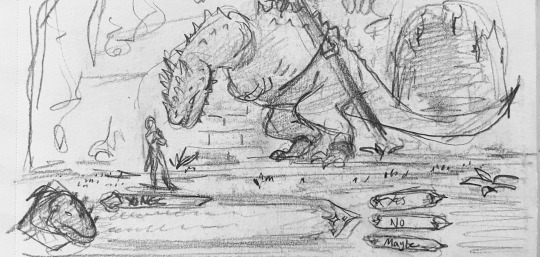

To this. (And come to think of it I might actually still want to make those cooler looking buttons in my sketch) 4. Break everything out into pieces and individual components. A good UI is made up of building blocks that you can reuse all over the place. That's how it stays consistent and also saves you a lot of stress when you need to go in and update components. Instead of a million different looking UI pieces, you just have to update the one! These individual components will make up your very own UI Component Library, which will be the standardized design system and source of reusable components for your project. This also applies to your visual elements that don't do anything (like I personally have a whole mini library of diamond and star shapes that I reuse everywhere).
For reference, here's a breakdown I made of my Inventory UI. On the right, I've labeled most of the individual components, and you might be able to see how I'm reusing them over and over again in multiple places.
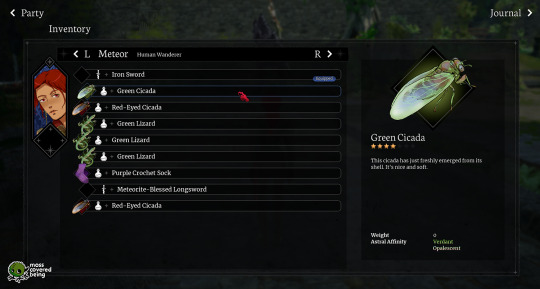
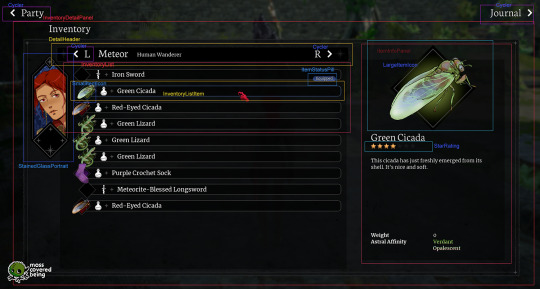
5. Spend some time listening to designers talk, maybe befriend some designers! Many of them have an unique, interesting view of the world and how we interact with it even beyond just software. Their perspectives will inform yours.
6. Test your UI on users whenever you can. Get feedback from others. This is the best way for you to see what works and what doesn't. As game devs we spend so much time with our games it's easy for us to lose sight of the full picture.
7. Be patient and don't give up. Continue to be open to expanding your knowledge. These UI skills take time to develop. I personally am still learning even after like 10 years of doing it. Coming up with the visual elements is very challenging for me and I spend a lot of time rearranging things in photoshop before I actually start coding anything at all in Unreal.
Whew, that was a lot, but I hope that gives you some thoughts and a place to start!
I don't have any posts out there about Blender/Unreal shader workflows right now, but I'll consider making another post sometime soonish. I appreciate you asking and you're welcome! :)
23 notes
·
View notes
Text
The Art of Asset Reduction: VNConf 2024 Write-Up
youtube
This is a write-up for my Visual;Conference 2024 talk on asset reduction: presentation of scenes with reduced art labor.
I will discuss how to reduce production requirements via various methods of asset presentation and staging, walking you through case studies of existing visual novels. This talk will guide you to answer the question: How do I fulfill my project scope without asset bloat?
This is an art talk that assumes you have already scoped down your story and have created a list of scenes that you need. This is not a talk about scoping down your game's story.
You have scenes you need to make. How are you going to make them (and with style)?
Abstraction
Cut-ins
Reduce
Reuse
-
I. Abstraction
I start off with abstraction as a reminder that visual novels are a combination of visual and novel (amongst other aspects)
Abstraction
Abstraction is a strong tool for bringing focus to the writing, highlighting ambiguity and setting the mood with colors.
Examples I mentioned in my talk include:
Black screen
Solid colored screen
Sky BG
Of Components
The mood-setting power of abstraction also extends to scenes with characters, especially CGs.
As again, abstraction draws focus to what you choose to emphasize: the characters.

(FLOWERS -Le volume sur ete-)
They are gay. Thank you for coming to my VNConf talk.
-
You can similarly abstract characters.

(Lachesis or Atropos)
Consider representing irrelevant characters (e.g., NPCs) as silhouettes. The reader can fill in the details within the shapes themselves.
Silhouettes are especially great for crowd scenes where you want to draw focus to the main characters.
This will be a recurring theme:
What do you really need to draw?
-
II. Cut-ins
One common not-quite full screen piece of art you'll see in many visual novels is the cut-in.
The cut-in typically consists of the:
Item/focus
Frame
And is often for topics such as objects or small animals, which may exist in the scene but may not be within the same frame of reference as the background and sprites.
The separate framing informs the players that the item is "separately framed."
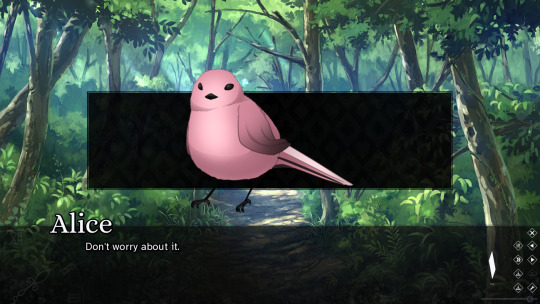
(Who is the Red Queen?)
For example, this small bird is not huge and would not be the size of a character's head even had a sprite been on screen.
The Foreground-Backdrop Heuristic
Cut-ins make strong use of what I refer to as the "foreground-backdrop heuristic."
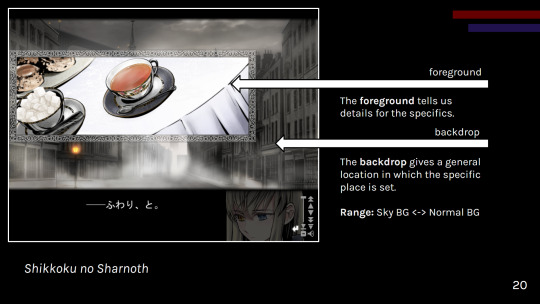
(Shikkoku no Sharnoth)
A general backdrop informs the reader of a broad location or scene (especially if characters are present). Then a more specific foreground (the cut-in) informs the reader of the specifics.
As the foreground cut-in is in a different frame, the pairing of the two helps create a mental model of the space in the reader's mind.
Cut-ins can be used for:
Backgrounds (mix and match foregrounds with a backdrop)
Reduced CGs
Presenting existing assets in a different frame of reference
CG variants
Try tackling your visual presentation in a layered, comic book-esque fashion with cut-ins!
Just be careful about clutter.
Whether you want to go for the layered cut-in style, the 3d stage cinematic style, or a combination of the two, make sure you have a vision before you jump in.
SD CGs
I had to make an obligatory mention of SD "super deformed" CGs in this talk, so here it is in the write up as well.
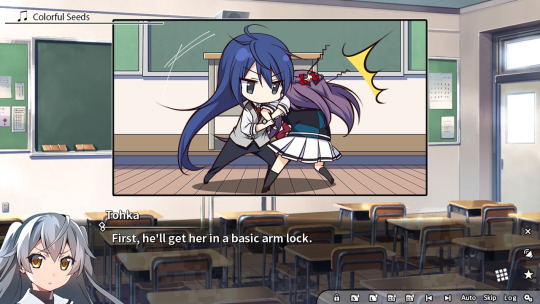
(Grisaia: Phantom Trigger Vol. 1)
SD, chibi. However you call these, they're great for playful scenes that might require more art than your classic sprite-background combination.
What SD CGs do best is that they:
Fulfill the role of a CG
Are easier to draw than fully rendered non-chibi art
Can be distributed to different artists to reduce artist workloads due to style difference
Just keep in mind that a simplified CG is still a CG and thus may lack reusability.
Consider what scenes really need a CG.
-
III. Reduce
Now, consider asking yourself: "Does what a player does not see need to exist?" (mostly applicable for games with opaque UI)
Yet, what you need to draw is what you need to draw. How can you reduce the work in what you need to draw?
One option is:
Palette Limitation
You've heard of gray scale games, but don't forget about other ways of limiting your palette to reduce workload.
Dramatic, mood setting color power
Less rendering work
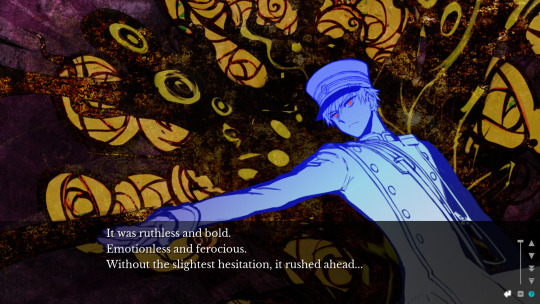
(Sona-Nyl of the Violet Shadows)
A similar idea can be applied to NPCs for a more detailed take on silhouettes.
-
IV. Reuse
Lastly, please remember to be economical and reuse assets as necessary. One of the great joys of cut-in BGs, for example, is reusability.
I had to give an obligatory mention to CG variants in my talk, such as:
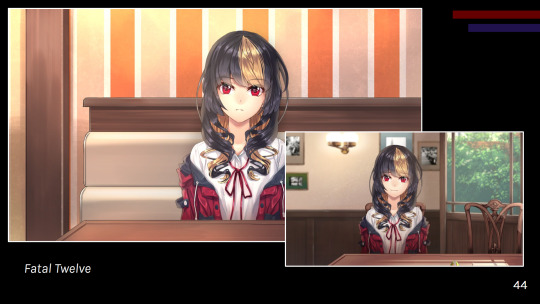
(Fatal Twelve)
However, overall, you never know when you'll want to use various components of your art elsewhere such as intermixing CG and sprite art.
Please keep your working layers if possible.
Other reuse examples:
UI (especially in episodic games)
Gameplay (e.g., Kogado's rhythm game)
Consider asking your programmer to work on a framework to reuse, reducing repeated code work.
-
Conclusions
All in all, you can make your game.
And it doesn't need to be hellish on your budget or timeline.
If you take anything away from this talk, let it be to:
Prioritize reusable assets
Maintain aesthetic; avoid clutter
Display important scenes
Do not scope up; aim for a set goal
A scene can be presented in many stylish ways, some of which will suit your workflow better than others.
So, go on. Make your game!
-
Interested in my works? Find me on itch:
And check out my newsletter:
-
VNConf 2023 Talk Write-up:
#visual novel development#vnconf#visual novel#vn#vndev#development guide#devlog#game development#talk write-up#gamedev#indiedev#this talk is also a yuri visual novel recommendation (kind of)#lachesis or atropos#shiei no sona-nyl#fatal twelve#grisaia phantom trigger#shikkoku no sharnoth#flowers visual novel#who is the red queen?
55 notes
·
View notes
Text
Best React Native App Developers in Indore for Android & iOS Solutions
Looking for top React Native app developers in Indore to build high-quality mobile applications? Young Decade is your trusted partner for developing scalable, feature-rich, and high-performance Android & iOS solutions. With our expertise in React Native development, we create apps that offer a seamless user experience across both platforms while ensuring cost-effective development.

Why Choose Young Decade for React Native App Development?
✅ Cross-Platform Excellence – Develop once, run on both Android and iOS without compromising performance. ✅ Custom Mobile Solutions – We tailor apps to meet your specific business needs. ✅ Fast Development & Deployment – Reduce time-to-market with efficient coding and reusable components. ✅ Engaging UI/UX – Deliver visually stunning and interactive mobile experiences. ✅ Performance-Optimized Apps – Build applications that load fast and run smoothly.
At Young Decade, we focus on building secure, scalable, and business-driven mobile applications. Whether you need a startup MVP, an enterprise solution, or an eCommerce app, our expert React Native developers in Indore ensure cutting-edge development with the latest technologies.
Start Your React Native Project Today!
Partner with Young Decade for the best React Native app development services in Indore. Let’s build a powerful and efficient Android & iOS app that helps your business grow. Contact us now to get started! 🚀
#software development company#android app developers#app development company#best android app development company#software development#flutter app development company in Indore#react native app development company in indore#mobile app development company in Indore
2 notes
·
View notes
Text
What is Mern stack And Its importance? Before that I will Tell you the best institute for Mern stack course in Chandigarh.

What is Mern stack?
MERN Stack is a popular JavaScript-based technology stack used for building full-stack web applications. It consists of four key technologies:
MongoDB: A NoSQL database that stores data in a flexible, JSON-like format.
Express.js: A lightweight and fast backend framework for Node.js.
React.js: A front-end JavaScript library for building user interfaces.
Node.js: A runtime environment that allows JavaScript to run on the server side.
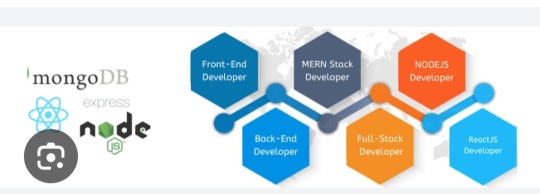
Importance of Mern Stack :
Full-Stack JavaScript – Uses JavaScript for frontend and backend, simplifying development.
High Performance – Node.js ensures fast, scalable applications.
Cost-Effective – Open-source, reducing development costs.
Rapid Development – React’s reusable components speed up UI building.
Flexibility – Suitable for web apps, SPAs, eCommerce, and real-time applications.
Scalability – MongoDB handles large data efficiently.
Strong Community Support – Large developer base ensures continuous updates and support.
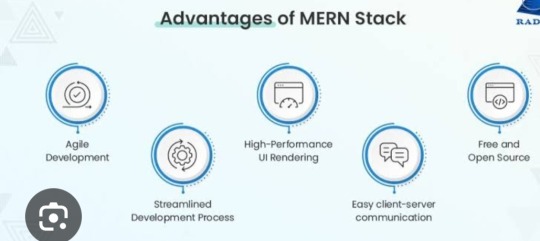
Now i will tell you the best institute for Mern stack course in Chandigarh .

Excellence Technology is a leading EdTech (Educational technology) company dedicated to empowering individuals with cutting -edge IT skills and bridging the gap between education and industry demands. Specializing in IT training ,carrer development, and placement assistance ,the company equipts learners with the technical expertise and practical experience needed to thrive in today's competitive tech landscape. We provide IT courses like python ,Full stack Development, Web Design ,Graphic Design and Digital Marketing.
Contact Us for more details: 93177-88822
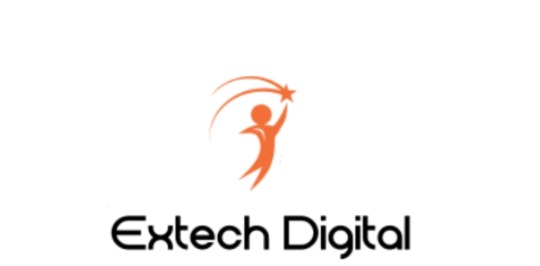
Extech Digital is a leading software development company dedicated to empowering individuals with cutting -edge IT skills and bridging the gap between education and industry demands. Specializing in IT training ,carrer development, and placement assistance ,the company equipt learners with the technical expertise and practical experience needed to thrive in today's competitive tech landscape. e provide IT courses like Python ,Full stack Development, Web Design ,Graphic Design and Digital Marketing.
Contact Us for more details: 93177-88822

Excellence academy is a leading software development company dedicated to empowering individual with cutting edge IT skills and bridging the gap between education and industry demands.specializing in IT training, career development, and placement assistance, the company equits learners with the technical expertise and practical experience needed to thrive in today's landscape. We provide IT courses like python, full stack development,Web design, and Digital marketing.
Contact Us for more details: 93177-88822
About Author
Nikita Thakur
Mern stack AI Developer/ 2+ years of experience
Excellence technology
Professional summary
Nikita thakur is a skilled MERN Stack AI Developer with over 2 years of experience at Excellence Technology. Proficient in MongoDB, Express.js, React.js, and Node.js, she integrates AI solutions to build scalable, high-performance web applications. Nikita excels in developing innovative solutions, enhancing user experiences, and driving business growth through technology.
2 notes
·
View notes
Text
Techniques in Flutter

Discover the advanced theming techniques in Flutter with our latest blog post! This comprehensive guide dives into the nuances of creating visually appealing and highly customizable applications. Learn how to implement themes, manage styles effectively, and leverage Flutter's built-in capabilities to enhance user experience. Whether you're a beginner or an experienced developer, this post provides valuable insights and practical tips to elevate your Flutter projects. Check it out now!
In this article, we cover essential concepts such as implementing light and dark themes, using theme data effectively, and managing styles for widgets. You'll also learn how to create reusable styles and explore best practices for maintaining a clean and organized codebase.
Whether you're a beginner looking to enhance your skills or an experienced developer aiming to refine your projects, this guide offers valuable insights and practical tips. Dive into the world of Flutter theming and elevate your app development to the next level!
4 notes
·
View notes
Text
Component Libraries: Should You Build Your Own or Use a Prebuilt One?

Component libraries are a vital tool in web application development in maintaining uniform design, shortening the time taken to develop web applications and improving reusability of the code. Some developers find this dilemma; should they create a component library or use an existing one? In addition, they help reduce the struggle while building well-designed and interactive websites because of the availability of animation-oriented UIs such as Accentricity UI among others. Now, let’s get more to the point in order to help you find the right way.
What is a Component Library?
Component libraries are collections of reusable UI elements such as buttons, forms, modals, and more— and are intended to reuse the components across several projects. Such libraries not only guarantee a consistent look of an application but also save time and costs during its implementation because the elements have been already coded. So, there's no need to build components from scratch.
Prebuilt Component Libraries

Prebuilt Component Libraries
Prebuilt component libraries are the ready-made collections of different UI components that are specifically designed and optimized for common use cases that developers can face during development. Some well-known examples include:
Material-UI (MUI):
A library based on React and it follows Google's Material-UI design, MUI allows a comprehensive set of components customization.
Ant Design:
It's an UI design system framework for enterprise-level products, ant design offers built-in themes and a rich set of UI components.
Bootstrap:
It's an widely-used CSS framework that provides basic components and a responsive grid system.
Pros of Prebuilt Libraries :
Rapid Development: Prebuilt libraries save a lot of time of the developers by providing pre-designed reusable components that you can quickly integrate into your project.
Standardized Design: They help ensure a consistent user experience across different screens and features.
Community Support: Many prebuilt libraries come with robust community support, providing a wealth of tutorials, plugins, and enhancements.
Cons of Prebuilt Libraries
Limited Customization: Customizing components to fit your unique design can sometimes be difficult, leading to constraints on flexibility.
Performance Overhead: Many prebuilt libraries come with extra features you may not need, which can bloat your codebase.

Pros And Cons of Prebuilt Libraries
Animation-Centric Libraries: Bringing UIs to Life
In recent years, a new category of libraries has emerged, specifically focused on providing built-in animations and smooth UI transitions. These libraries not only offer pre-designed components but also emphasize adding dynamic, interactive features to web applications.
Here are some popular examples of animation-focused libraries:
Lottie
Category: Animation Integration Library

Lottie:The industry standard for motion design
What it Offers: Lottie allows you to render animations created in Figma or Adobe After Effects as JSON files using the built-in plugins. These animations are then rendered natively on the web, offering high-quality motion without a heavy performance impact.
Why It’s Useful: Lottie is perfect for apps or websites requiring rich, scalable animations that are lightweight. It’s commonly used for logos, loading animations, and subtle UI effects. Unlike other component libraries, it focuses purely on bringing visual design elements from tools like Figma & After Effects into the web environment.
Accentricity UI
Category: Hybrid Component and Animation Library
What it Offers:
Accentricity UI combines traditional UI components with built-in support for smooth animations and transitions. It offers a wide range of components like buttons, forms, modals, and navigation menus, but with an added layer of predefined animations, making it easier to create interactive, dynamic interfaces.
In addition to these standard components, Accentricity UI provides responsive behaviors and subtle animation effects like hover states, fade-ins, and sliding transitions that enhance user engagement. The library's components are fully customizable, allowing developers to easily adjust animation timings, easing functions, and durations to match the look and feel of their brand, ensuring both visual appeal and performance across devices.
Why It’s Useful:
Think about it, what would be easy for a dev? Making a custom component with tons of animation which the dev has to write from scratch and polish it before the deadline or use a library, where the dev can make use of the library with the built-in support to combine the custom designed elements with smooth animations and transitions offered by the library.
It’s particularly helpful for developers who want the convenience of a prebuilt library but need polished, built-in animations to enhance user experience without writing complex animation code from scratch.
Framer Motion
Category: Animation-focused Component Library (React)

Framer Motion
What it Offers:
Framer Motion is a powerful library for React that allows you to create fluid animations and micro interactions with minimal effort. It supports interactive features like drag, scroll, and spring-based animations, which makes it ideal for interactive & highly animated UIs. It also provides easy-to-use APIs for gesture-based animations and layout transitions, offering developers extensive control over complex animations while maintaining simplicity in implementation.
Why It’s Useful:
Framer Motion combines the simplicity of component libraries with the flexibility of advanced animation frameworks, making it easy to enhance user interfaces with dynamic visual effects. It’s a great choice for React developers who want to integrate animation without compromising performance or adding significant overhead. With its built-in optimizations for smooth rendering, Framer Motion ensures high-quality animations that enhance both usability and visual appeal.
Should You Use Prebuilt Animation Libraries?
The role of animations is really important in web applications to enhance the UX(user experience), by making interfaces feel more fluid and interactive makes user's remember the website due to its great experience. Since users are constantly getting used to smooth effects, micro-interaction and dynamic feedback, animations are no longer viewed as a good to have feature but are rather considered as a must have feature. Prebuilt animation libraries like Framer Motion and GSAP (GreenSock Animation Platform) simplify this process by providing powerful, flexible tools that allow developers to integrate complex animations without having to manually manage every aspect of motion or dive deep into animation theory.
Advantages of Animation-Centric Libraries

Advantages of Animation-Centric Libraries
Ease of Use
Prebuilt animation libraries abstract away the complexities of coding animations from scratch. Without manually writing keyframes, easing functions, or browser-optimized transitions, developers can simply use predefined APIs to implement fluid animations. This drastically reduces development time, as many animation details are handled by the library, letting developers focus on building features and interactions rather than tweaking animations for performance or cross-browser compatibility. For example, with a few lines of code, animations can be applied to any UI element, making the development process much more efficient.
Advanced Features
Many animation libraries offer advanced features that go far beyond basic transitions like fade-ins and slide animations. These include timeline control, scroll-triggered animations, physics-based interactions, and even 3D transformations. For instance, timeline control allows developers to create synchronized sequences of animations, which can be used to create smooth, coordinated interactions across multiple elements. Scroll-based animations enhance user engagement by triggering effects as the user scrolls, perfect for parallax websites or content reveal effects. Physics-based animations, such as spring-based drag-and-drop or object bouncing, add natural, realistic movement to interactive elements, elevating the overall experience. Additionally, 3D transformations provide extensive control over how objects rotate, scale, or move in three-dimensional space, something that is cumbersome to achieve with native CSS alone.
See What Happens Next
#webdevelopement#werbooz#own website#build vs prebuilt component library#custom UI components#prebuilt UI libraries#web development#Material-UI#Ant Design#Bootstrap#Framer Motion#Accentricity UI#animation libraries#best UI libraries 2024#component library pros and cons#web app development#UI design optimization#web performance#web development trends
2 notes
·
View notes
Text
Creating a Reusable Component Library in Angular
Overview Are you tired of writing the same code over and over again in your Angular applications? Do you want to improve code reusability and simplify the development process? Look no further! Creating a reusable component library is the answer. Why Use a Component Library? A component library is a collection of reusable UI components that can be shared across multiple projects. It provides…
#Angular#Angular component library#Component Library#CSS#development#Front-end Development#Reusability#reusable components#UI development
0 notes
Text
Mastering the Art of Hiring MERN Stack Programmers: A Step-by-Step Guide
The MERN stack is a popular technology stack. It is an acronym that stands for MongoDB, Express.js, React, and Node.js. Each component of the MERN stack serves a specific purpose in the development process. MongoDB is a NoSQL database that stores data in a JSON-like format, making it flexible and scalable. Express.js is a web application framework for Node.js that provides a set of features for building web applications and APIs. React is a JavaScript library for building user interfaces, and it allows developers to create reusable UI components. Node.js is a server-side JavaScript runtime that allows developers to build scalable network applications. The MERN stack is known for its flexibility, efficiency, and performance. It allows developers to build full-stack applications using JavaScript, which makes the development process more streamlined and cohesive. Additionally, the MERN stack is well-suited for building real-time applications and single-page applications (SPAs). With its robust set of tools and technologies, the MERN stack has become a popular choice for businesses looking to develop modern, responsive web applications.
The Benefits of Hiring MERN Stack Programmers
Hiring MERN stack programmers can offer numerous benefits to businesses looking to develop web applications. MERN stack programmers are skilled in using MongoDB, Express.js, React, and Node.js to build dynamic and responsive web applications. They are proficient in JavaScript and have a deep understanding of the MERN stack architecture, making them valuable assets to any development team. MERN stack programmers are also well-versed in modern web development practices and can leverage the latest tools and technologies to build high-quality applications. They are capable of developing scalable and efficient web applications that can handle large amounts of data and traffic. Additionally, MERN stack programmers are adept at building real-time applications and SPAs, which are increasingly in demand in today's digital landscape. Furthermore, hiring MERN stack programmers can lead to faster development cycles and reduced time-to-market for web applications. Their expertise in the MERN stack allows them to build applications more efficiently, resulting in cost savings and improved productivity for businesses. Overall, hiring MERN stack programmers can provide businesses with the technical expertise and skills needed to develop modern, responsive web applications.
Where to Find Qualified MERN Stack Programmers
Finding qualified MERN stack programmers can be a challenging task, but there are several avenues businesses can explore to locate top talent. One option is to utilize online job boards and platforms specifically tailored to tech professionals, such as GitHub Jobs, Stack Overflow Jobs, and AngelList. These platforms allow businesses to post job listings and connect with experienced MERN stack programmers who are actively seeking new opportunities. Another option is to partner with specialized tech recruitment agencies that have access to a network of skilled MERN stack programmers. These agencies can help businesses identify and recruit top talent by leveraging their industry connections and expertise in the tech sector. Additionally, businesses can attend tech conferences, meetups, and networking events to connect with MERN stack programmers and build relationships within the tech community. Furthermore, businesses can explore freelance platforms such as Upwork and Toptal to find qualified MERN stack programmers who are available for short-term or project-based work. These platforms provide businesses with access to a global pool of tech talent and allow them to review portfolios and work samples before making hiring decisions. Overall, there are several avenues businesses can explore to find qualified MERN stack programmers, each with its own unique advantages and considerations.
How to Evaluate MERN Stack Programmers
Evaluating MERN stack programmers requires a comprehensive approach that takes into account their technical skills, experience, and cultural fit within the organization. One way to assess their technical proficiency is by conducting coding assessments or technical interviews that test their knowledge of JavaScript, MongoDB, Express.js, React, and Node.js. These assessments can help businesses gauge a candidate's ability to solve complex problems and write clean, efficient code using the MERN stack. Another important aspect to consider when evaluating MERN stack programmers is their experience with building real-world applications using the MERN stack. Reviewing their portfolio and work samples can provide insight into the quality of their previous projects and their ability to deliver high-quality web applications. Additionally, businesses can ask candidates about their experience with specific tools and technologies within the MERN stack, such as Redux for state management in React applications or Mongoose for interacting with MongoDB. Cultural fit is also an important factor to consider when evaluating MERN stack programmers. Businesses should assess a candidate's communication skills, teamwork abilities, and willingness to learn and adapt within a dynamic development environment. Conducting behavioral interviews or team-based exercises can help businesses gauge a candidate's interpersonal skills and how well they align with the company's values and culture. Overall, evaluating MERN stack programmers requires a holistic approach that considers their technical skills, experience, and cultural fit within the organization.
Interviewing MERN Stack Programmers
Interviewing MERN stack programmers requires careful preparation and consideration of the specific skills and qualities needed for the role. One approach is to conduct technical interviews that assess a candidate's knowledge of JavaScript, MongoDB, Express.js, React, and Node.js. These interviews can include coding exercises, problem-solving scenarios, or discussions about best practices for building web applications using the MERN stack. Another important aspect of interviewing MERN stack programmers is assessing their experience with building real-world applications and their ability to work within a team environment. Asking candidates about their previous projects, challenges they faced, and how they collaborated with other team members can provide insight into their practical skills and teamwork abilities. Additionally, businesses can use behavioral interviews to assess a candidate's communication skills, problem-solving abilities, and how well they align with the company's values and culture. Furthermore, businesses should consider conducting interviews that focus on specific tools and technologies within the MERN stack, such as Redux for state management in React applications or Mongoose for interacting with MongoDThese interviews can help businesses gauge a candidate's depth of knowledge in key areas of the MERN stack and their ability to leverage these tools effectively in real-world scenarios. Overall, interviewing MERN stack programmers requires a comprehensive approach that assesses their technical skills, practical experience, and cultural fit within the organization.
Onboarding MERN Stack Programmers
Onboarding MERN stack programmers is an important process that sets the stage for their success within the organization. One approach is to provide them with comprehensive training on the specific tools and technologies within the MERN stack, such as Redux for state management in React applications or Mongoose for interacting with MongoDThis training can help new hires become familiar with the company's development environment and best practices for building web applications using the MERN stack. Another important aspect of onboarding MERN stack programmers is integrating them into the development team and providing opportunities for collaboration and knowledge sharing. Pairing new hires with experienced team members or mentors can help them acclimate to the company's culture and development processes while also providing them with valuable guidance and support as they ramp up on new projects. Furthermore, businesses should consider providing new hires with access to resources such as documentation, code repositories, and development tools that will help them navigate their day-to-day responsibilities more effectively. This can include access to internal wikis or knowledge bases that contain information about the company's development processes, coding standards, and best practices for working with the MERN stack. Overall, onboarding MERN stack programmers requires a thoughtful approach that provides them with the training, support, and resources needed to succeed within the organization.
Retaining MERN Stack Programmers
Retaining MERN stack programmers requires ongoing efforts to support their professional growth, provide meaningful work opportunities, and foster a positive work environment. One approach is to offer professional development opportunities such as training programs, workshops, or certifications that allow MERN stack programmers to expand their skills and stay current with industry trends. This can help them feel valued within the organization and provide them with opportunities for career advancement. Another important aspect of retaining MERN stack programmers is providing them with challenging and meaningful work that allows them to leverage their skills and contribute to impactful projects. Offering opportunities for ownership over projects or involvement in decision-making processes can help keep MERN stack programmers engaged and motivated within their roles. Furthermore, fostering a positive work environment that values open communication, collaboration, and work-life balance can contribute to higher job satisfaction among MERN stack programmers. Providing opportunities for team-building activities, social events, or flexible work arrangements can help create a supportive and inclusive culture that encourages retention. Overall, retaining MERN stack programmers requires ongoing efforts to support their professional growth, provide meaningful work opportunities, and foster a positive work environment that values their contributions. By investing in their development and well-being, businesses can increase retention rates among their MERN stack programmers and build a strong foundation for long-term success within their development teams.
2 notes
·
View notes
Text
Top 10 Front-End Frameworks and Libraries for 2024
As the web development landscape continues to evolve, staying updated with the latest front-end frameworks and libraries is crucial for any developer. Whether you're a seasoned pro or just starting out, knowing which tools to use can significantly impact your productivity and the quality of your projects. In this post, we’ll explore the top 10 front-end frameworks and libraries that are set to dominate in 2024.
1. React
React remains one of the most popular front-end libraries, known for its simplicity and flexibility.
Key Features of React
Component-Based Architecture: Reusable components make development efficient and manageable.
Virtual DOM: Enhances performance by minimizing direct DOM manipulation.
Strong Community Support: A vast ecosystem of tools, libraries, and tutorials.
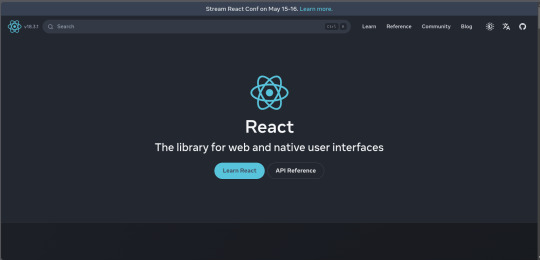
2. Angular
Angular, backed by Google, is a powerful framework for building dynamic single-page applications (SPAs).
Why Choose Angular?
Two-Way Data Binding: Synchronizes data between the model and the view.
Dependency Injection: Improves code maintainability and testability.
Comprehensive Documentation: Extensive resources for learning and troubleshooting.
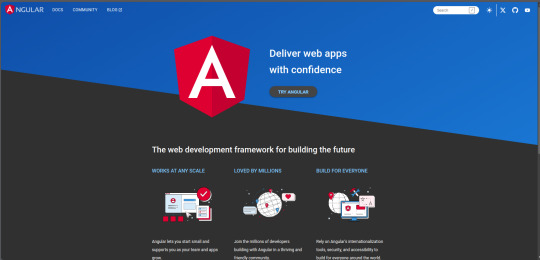
3. Vue.js
Vue.js has gained popularity due to its gentle learning curve and versatility.
Advantages of Vue.js
Reactive Data Binding: Simplifies state management.
Single-File Components: Encapsulate HTML, CSS, and JavaScript in one file.
Flexibility: Can be used for both large-scale and small-scale applications.
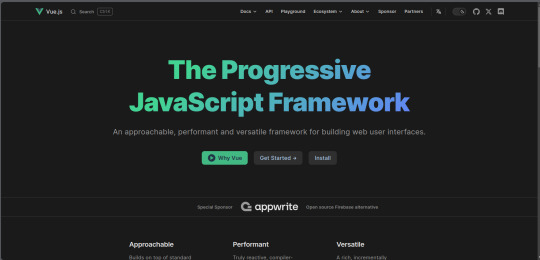
4. Svelte
Svelte is a relatively new player that compiles components into highly efficient vanilla JavaScript at build time.
Svelte’s Standout Features
No Virtual DOM: Directly manipulates the DOM for better performance.
Less Boilerplate: Cleaner code with minimal overhead.
Ease of Use: Intuitive and straightforward syntax.
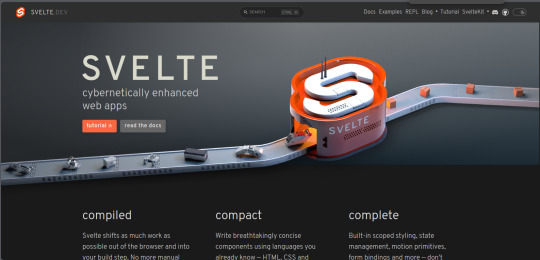
5. Bootstrap
Bootstrap is a front-end framework that provides pre-designed components and a responsive grid system.
Benefits of Using Bootstrap
Responsive Design: Ensures your site looks great on all devices.
Pre-Styled Components: Saves time with ready-to-use UI elements.
Customizable: Easily customize with Sass variables and Bootstrap’s extensive options.
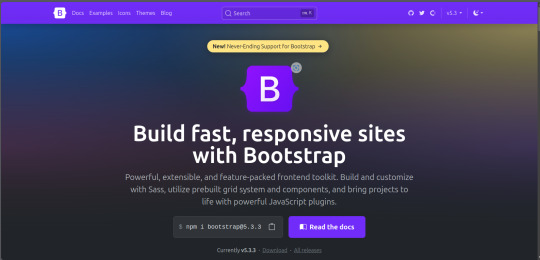
6. Tailwind CSS
Tailwind CSS is a utility-first CSS framework that allows for rapid UI development.
Tailwind CSS Features
Utility-First Approach: Use utility classes directly in your HTML.
Customizable: Extensive configuration options to suit your project’s needs.
Consistency: Enforces a consistent design language across your project.
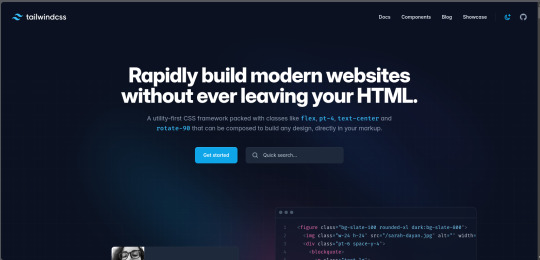
7. Ember.js
Ember.js is a robust framework for building ambitious web applications.
Why Ember.js Stands Out
Convention over Configuration: Reduces the amount of decision-making and boilerplate code.
Strong Routing: Powerful routing capabilities for managing application state.
Productivity: Focuses on developer productivity with built-in best practices.
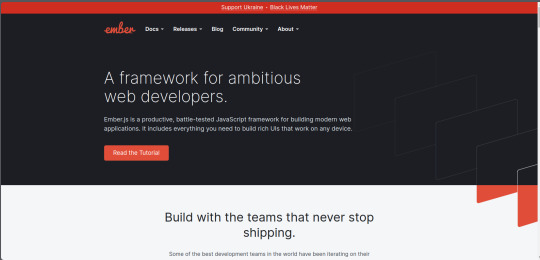
8. Alpine.js
Alpine.js offers a minimal and lightweight way to add interactivity to your websites.
Key Features of Alpine.js
Lightweight: Small footprint with only a few kilobytes.
Declarative Syntax: Similar to Vue.js, making it easy to understand and implement.
Ease of Integration: Can be easily integrated into existing projects.
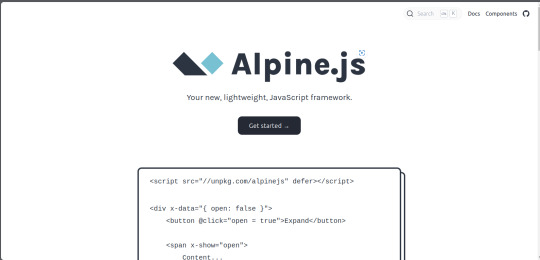
9. Next.js
Next.js is a popular React framework that enables server-side rendering and static site generation.
Benefits of Using Next.js
Server-Side Rendering (SSR): Improves performance and SEO by rendering pages on the server.
Static Site Generation (SSG): Pre-renders pages at build time for fast load times.
API Routes: Allows you to create API endpoints within your application.
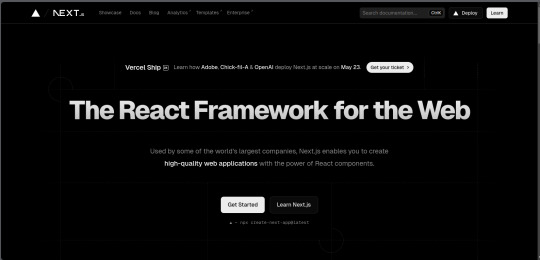
10. Lit
Lit is a simple library for building fast, lightweight web components.
Advantages of Lit
Web Components: Embraces the web components standard for reusable, encapsulated HTML elements.
Performance: Lightweight and highly performant.
Simple API: Easy to learn and use with a minimal API surface.
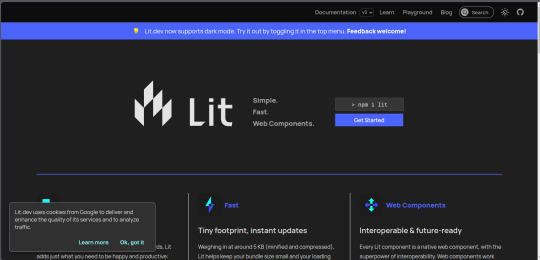
Conclusion
Choosing the right front-end framework or library can significantly impact your workflow and the quality of your projects. Whether you prefer the flexibility of React, the structure of Angular, or the simplicity of Svelte, there's a tool out there to suit your needs.
Final Tips for Selecting a Framework or Library
Project Requirements: Consider the specific needs of your project.
Community and Support: Look for frameworks with strong community support and documentation.
Learning Curve: Choose a tool that matches your current skill level and the time you have available to learn.
By staying informed about the latest tools and trends, you can ensure that your skills remain relevant and that you can deliver the best possible results in your projects. Happy coding!
Remember, the best tool is the one that helps you get the job done efficiently and effectively. So, dive into these frameworks and libraries, and take your front-end development skills to the next level!
Share Your Thoughts
I'm curious to know your thoughts on these front-end frameworks and libraries. Have you used any of them in your projects? Which one is your favorite, and why? Share your experiences and insights in the comments below.👇
2 notes
·
View notes
Text
Sounding performant
I had a late night last night tweaking things and getting a bit carried away with all-things audio.
There's quite a lot to cover from those developments, and there's some nerdy performance-related discussion later further down - so skip past all that if it's of no interest!
For now, here's a quick look at some of the work done on the audio system:
Now with sounds and music!
I spent a while working on the audio system for the game. This included setting up a bunch of initial sound effects for various things. Chief amongst these are the UI sounds - something I'm always really keen on getting right (I haven't yet added any audio to main menu screen yet though).
I've always been a fan of more understated audio feedback. Whilst it's nice to have solid, heavy-sounding call-to-action feedback in certain games, for games like this where you're continually interacting with the UI, I prefer to aim for very short clicks and pops.
I also wanted to get two other main things sorted out - the ambient background loop and some sort of music jukebox of sorts (nothing the player can see, this is an internal thing). The ambience is a kind of airy, factory-esque soundscape I discovered whilst hunting for loops, and I trimmed out a nice portion for a continual ambient loop.
How did I make a non-looping sample loop?
I discovered a neat trick some years back to loop any audio sample seamlessly. It's a similar trick to how you create seamless repeatable textures (in a weird kind of way).
Open up the sample in your program of choice. In this example I'm using Audacity.
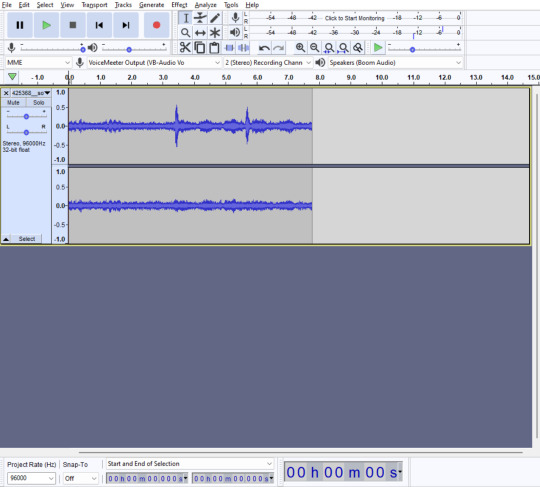
2. Cut the sample in half from somewhere near the middle, and paste it onto a new track. Move the first half you just cut to begin almost as the second part ends (below they're arranged so that the first part begins about 1 second before the last part ends).
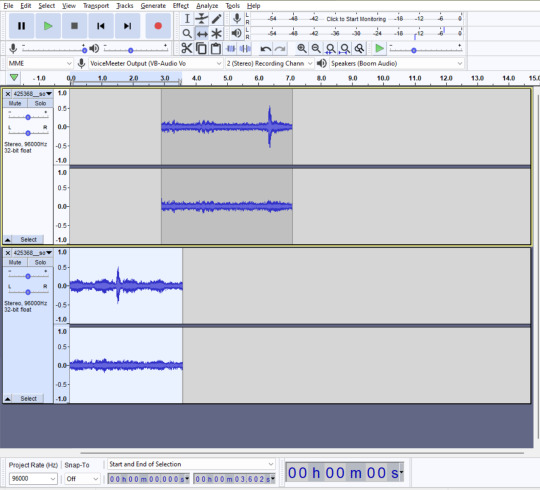
3. Fade-in the first part, and fade-out the last part by as much as the overlapped section (in my example they overlap by about 1 second, which is what I set both their fade in/out durations to):
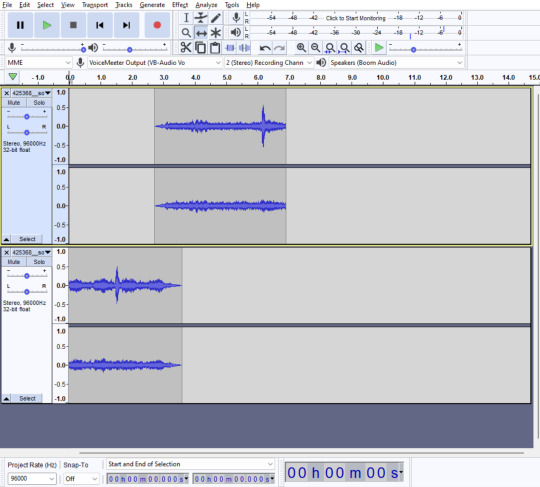
And that's it! A perfectly looping sample! You can move the first track to start a bit earlier if you want to make the blend between them a little more balanced. For me, this strategy has worked countless times.
Music management
I discovered some nice royalty free, CC BY-SA licensed audio and music which I can attribute in the game's credits screen. I set up a background music randomiser so that it'll shuffle all the audio tracks and play them in order at a fairly low-key background volume.
The game has four primary audio mixers - effects, ambience, music, and master. The latter controls all the others, but having separate channels for each audio lane will let me add sliders that the players can control the levels of each. Something I'm sure players appreciate for their specific tastes.
Beyond this I had to spend some time setting up a global audio singleton (for easy reusability elsewhere in the game), and a lot of time in Audactity trimming and normalising a bunch of sound effects. The net result of all of this is in the video I linked earlier.
The big performance discussion
A few posts ago, I talked about the importance I attached to making sure the game was performant. In games where you allow the player to effectively build whatever they want in moreorless unlimited numbers, performance becomes a tabled issue before too long. It's also something worth considering as a matter of principle when developing a game, because not everybody will share the same specifications of your development machine.
I'm developing this game on a PC with an AMD Ryzen 5 3600 and an nVidia 2070 Super. Not exactly 'prime gamer' specs, but maybe a bit higher than some folks who might want to play the game. Therefore, shooting for a decent level of optimisation is an important element for me.
I'm not trying to run the game on a potato or anything, but I'd like to ensure I'm making some basic optimisations if nothing else.
Stress testing
One of the best ways I've found of testing the game under load is to simply scale everything up. More objects, more running logic, more rendering. The works.
To this end, I created a stress testing class which I can just switch on in the project.

I've found that my current default map size of 40 allows for a pretty big factory, though the player may have to work up to that size initially. 40 feels like a good maximum, but why stop there? I want the ability to test the game at an arbitrary size - even far exceeding what I ever envisage it to be used for.
I find that the more you scale up, the easier it is to spot glaring problems in either the code or the rendering. To this end, I decided that the main likely culprit of code slowdowns would either be my belt logic, or my machine loop code.
To get started, I first needed a benchmark to test against.
Here is what the game runs like with absolutely nothing loaded into the level. Predictably, with no loaded machines or belts, and no logic being processed, it runs pretty fast as an empty level:

The test structure
When you enable the stress test, the game doesn't load a previous level, but instead lays out a level structure in an algorithmic format, following some layout rules and placement logic.
I first create a routine that adds an extractor against the edge of the level, then places down the maximum density of belts to reach the other size of the map - which is a zig-zag pattern. In order to get a couple of machine's worth of processing out of this layout (and to make sure it actually functions as a factory line), I drop an Analyzer on the end of it.
It looks something like this:

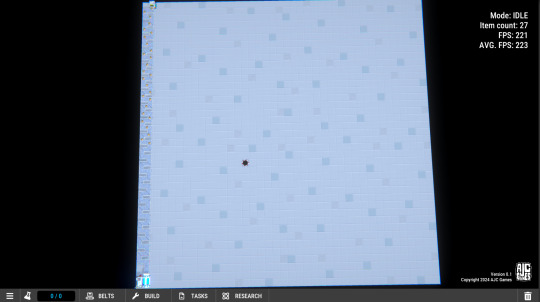
Then, I simply repeat this for every odd-numbered column in the level, and you then end up with this monster:

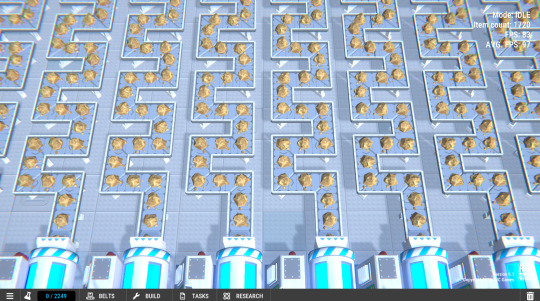
That is moreorless the maximum number of things you can put in a 40x40 level. Rather a lot.
Crucially though, this is where I can start looking at the raw numbers and see where my performance bottlenecks are.
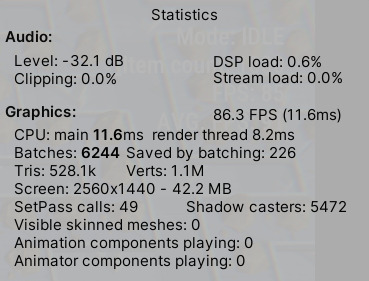
Immediately I can see several problems.
There are way too many Batches being handled, along with a ludicrous number of Shadow casters. The render time of 11.6ms is both unsurprising and a little disappointing.
But this is without any optimisations having been made. So I can move straight on to the obvious things: static meshes.
There's thousands of items in this stress test, all being updated. But lots of things (machines & belts) never move and never rotate during the game once they're placed. You can combine these into static meshes to improve draw performance, along with allowing their materials to be GPU instanced to combine them together into single draw calls for each shared material object.
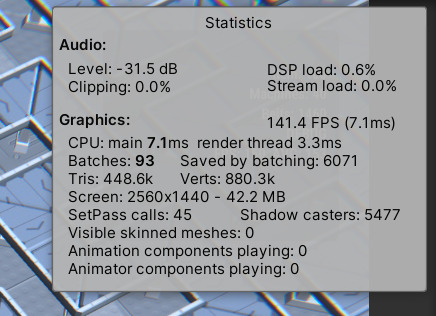
The effect is immediate, and almost doubled the average FPS available in this stress test.
I continued on, tweaking things like shadow complexity and removing them completely from some objects that didn't need to cast shadows at all. After a bunch of optimisations I had managed to get a stabilized average frame rate of around 180 fps.
There are definitely logic improvements I could make, but after running a lot of profiling on the game I was starting to make only tiny sub-millisecond improvements to the frame time.
After all my tweaks, I decided to go all-out and double the stress test map size.
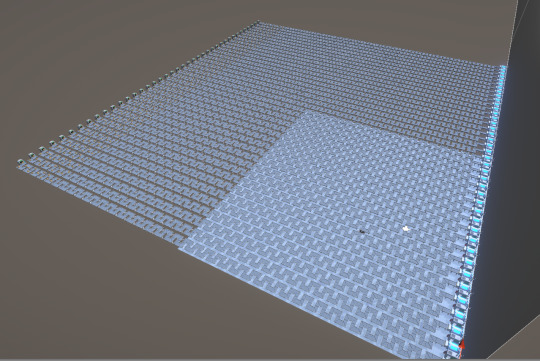
I was plesantly surprised at how well it ran. If nothing else, it showed how well the belt code was working under such immense load.
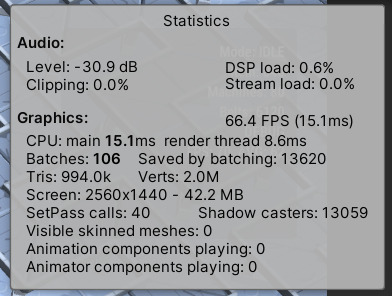
Again, I should stress that there is no way there will be a need for 80x80 factory sizes, at least not in my current plan for the game. But it's nice to know that I'm still getting over 60 fps even at that extreme level.
Going above and beyond 80x80 footprints for a level would likely require some re-thinks about how I collate and render the level entirely. I'm convinced I can still do a lot of work about these shadow casters, but I'll need to do some research there. Shadows are notoriously expensive in graphics processing, so I'd like to fully understand what's going on there and mitigate it as much as possible. I expect I can make some additional gains to the FPS when I do so.
Anyway, that's about all I have for this one. I hope you enjoyed if you made it this far, and sorry it was such a long one. Hopefully you have a great day, wherever you are!
2 notes
·
View notes
Text
J/A: script investigating the goat and the feed
MW: image library detection/display
MW: upload button
exercise, including a half hour on the new elliptical
prepare battlemap for D&D with little brothers
Escher’s Gap session
so... i bit off more than i could chew with Medallion Works today.
i figure, okay, we don't want the user to have to re-upload their assets every single time they want to set an image for something. maybe they have some generic soldier portraits that get reused for multiple enemies, or they want to make multiple versions of the same character with different stats for different maps. so when you go to upload a sprite for a unit to use, that should go in the custom assets folder, and then when you make the next unit you should be able to just pick that sprite again without opening a file upload dialog.
but what's that look like in terms of UI? what's faster than opening the file picker and picking out the file? hang on, there isn't one. if i just have it open up the OS's file picker in the relevant custom assets folder, that does all the work for me. so i just do that, right?
mmmmno. no i don't just do that. because the renderer process is of course an emulated browser, which by design isn't allowed to know anything about the user's filesystem. i can only do that from the main process, which is Node.js- and for some reason this too is not easy. apparently "open a file select dialog, specifically starting in a known subfolder of the current directory" is an uncommon task that like two hours of googling tangentially related questions does not provide insight into performing, and suggests is in fact not actually possible. what? seriously?
so i guess instead my only option is to... uh, build an entire reusable fully-featured file explorer component on the front end, just to ensure the user opens up the right image asset subfolder depending on which part of the editor they're working in. this seems suboptimal and like too much work, but i did already get display and selection working today, so...
i guess next step is pull it out of the gallery component i built it for and make it a reusable modal component, and then like... refactor the image asset list retrieval code to organize things by subfolders, and then write some dragging code to allow moving assets between folders, and implement actions like copying, pasting, deleting...
ugh. there really should be an easier way to do this than reinventing that particular wheel.
3 notes
·
View notes
Text
Maximizing Test Effectiveness: Unraveling the Advantages of Selenium in Web Testing
Introduction: Selenium, a prominent automation testing framework, has redefined the landscape of web application testing. Renowned for its versatility, user-friendliness, and robust capabilities, Selenium is an indispensable asset for professionals engaged in software testing. In this discourse, we explore the manifold advantages of utilizing Selenium for web testing and elucidate how it empowers testers to achieve optimal outcomes.

1. Precision and Dependability: Selenium provides precise and dependable element identification, enabling testers to accurately pinpoint and interact with web elements on a page. Leveraging unique attributes such as IDs, classes, or XPath expressions, Selenium ensures tests execute consistently and yield reliable results across various browsers and environments.
2. Enhanced Test Stability: Selenium bolsters test stability by mitigating the impact of changes in the application under test. Selenium locators are adept at withstanding alterations in page layout or structure, ensuring tests remain stable and impervious to minor UI modifications. This stability is pivotal for upholding the integrity of test suites and ensuring accurate validation of application functionality.
3. Improved Test Efficiency: Leveraging Selenium for web testing enhances efficiency and productivity by automating repetitive testing tasks. By automating routine test cases, testers can allocate their time and effort toward more intricate scenarios and exploratory testing, thereby expediting the overall testing process and reducing time-to-market for web applications.
4. Cross-Browser Compatibility: A standout feature of Selenium is its cross-browser compatibility, facilitating test execution across diverse web browsers with minimal effort. Selenium WebDriver seamlessly supports popular browsers like Chrome, Firefox, Safari, and Edge, ensuring consistent test execution and compatibility across varied browser environments.
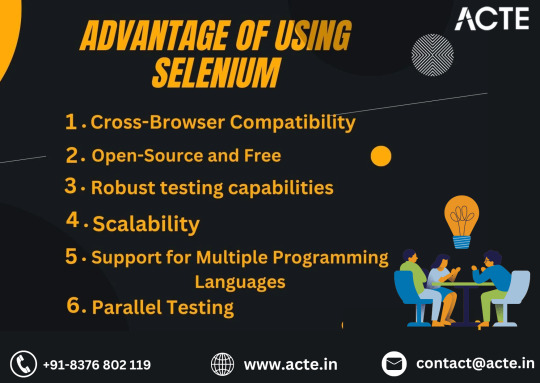
5. Seamless Integration with Testing Frameworks: Selenium seamlessly integrates with a myriad of testing frameworks, enabling testers to harness their preferred tools and methodologies. Whether utilizing TestNG, JUnit, or NUnit, Selenium can be effortlessly integrated into existing testing workflows, affording flexibility and customization options tailored to the needs of individual testing teams.
6. Scalability and Reusability: Selenium advocates scalability and reusability through its modular test design and component-based architecture. Test scripts and components can be modularized and repurposed across multiple test cases, curbing duplication of effort and maintenance overhead. This modular approach fosters test maintainability and facilitates the creation of robust, scalable test suites.
7. Cost-Effectiveness: By automating web testing tasks, Selenium aids organizations in trimming manual testing efforts and associated costs. Automated tests can be executed repeatedly sans additional expenses, resulting in long-term cost savings and heightened return on investment. Additionally, Selenium's open-source nature obviates licensing fees, rendering it a cost-effective choice for organizations of all sizes.
8. Comprehensive Test Coverage: Selenium empowers testers to attain comprehensive test coverage by supporting a gamut of testing scenarios and workflows. From functional and regression testing to performance and compatibility testing, Selenium caters to diverse testing requirements, ensuring thorough validation of web applications across various dimensions.
In summation, Selenium offers a plethora of advantages for web testing, encompassing precision and reliability, enhanced test stability, improved efficiency, cross-browser compatibility, seamless integration, scalability, cost-effectiveness, and comprehensive test coverage. By harnessing the power of Selenium, testers can streamline their testing endeavors, augment test coverage, and deliver high-quality web applications that align with the expectations of end-users and stakeholders alike.
2 notes
·
View notes